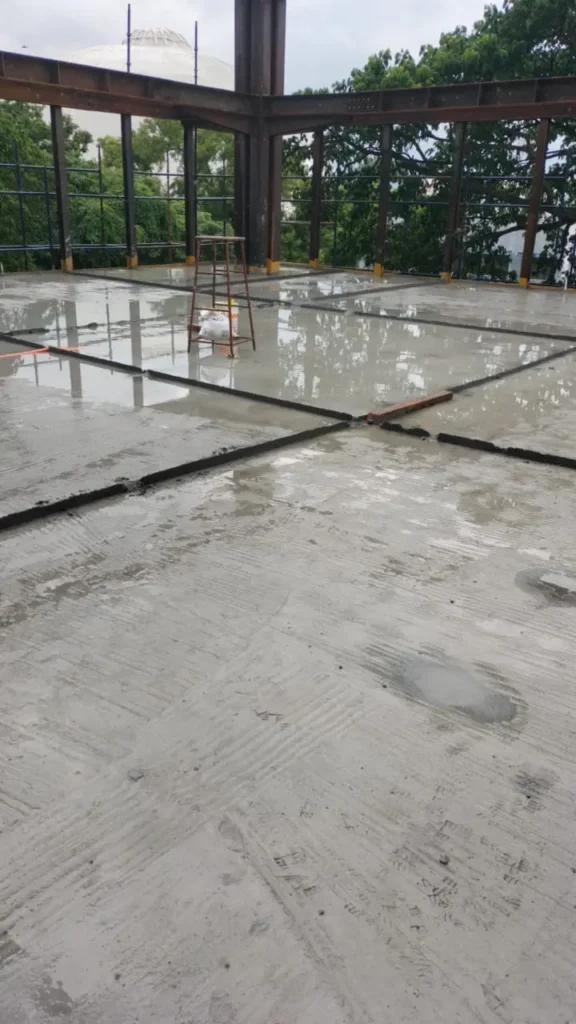Light Weight Concrete


Light Weight Concrete
Largest Cast In-situ Light weight Concrete Supplier in India
Light Weight Concrete

Product Details
| Property | Description |
|---|---|
| Material Type | Lightweight Concrete |
| Composition | Cement, Lightweight aggregates, and water |
| Density | Ranges from 300 KG/CBM to 1600 KG/CBM |
| Colour | Grey |
| Strength | 10 Mpa to 30 Mpa (varies according to density) |
| Thermal Conductivity | Good insulation properties due to lightweight aggregates |
| Application |
|
| Advantages |
|
Introduction: Smart Solutions with Light Weight Concrete
Light weight concrete is increasingly becoming the smartest choice for both building and infrastructure projects due to its cost-saving, time-saving, and environmentally friendly properties. As a leading light weight concrete supplier in South India, JB International provides a comprehensive range of solutions tailored to meet the diverse needs of modern construction. We are committed to being your rapid speed solution provider, ensuring your projects are completed efficiently and effectively.
Understanding Light Weight Concrete:
Traditional concrete typically has a density of around 2200 kg/CBM. Light weight concrete, on the other hand, is significantly lighter, offering numerous advantages. It is primarily used for non-structural applications, such as:
- Sunken Slab Filling: Providing a lightweight and efficient filling material for sunken slabs.
- Light Weight Floor Filling: Reducing the load on floors, simplifying construction.
- Roof Insulation: Offering excellent thermal insulation properties, enhancing energy efficiency.
The unique characteristics of light weight concrete support constructions in various aspects, making it a valuable material for modern building practices. Unlike normal concrete, which uses coarse aggregates, light weight concretes are made with different fillers, contributing to their lighter weight.
JB International: Your Trusted Light Weight Concrete Supplier:
As your go-to light weight concrete supplier in South India, JB International ensures:
- Rapid Speed Solutions: We understand the importance of timely project completion. Our efficient supply chain guarantees prompt delivery, catering to the rapid pace of your projects.
- Diverse Range of Products: We offer a variety of light weight concrete types, ensuring we meet the specific requirements of your projects.
- Cost-Effective Solutions: Light weight concrete reduces structural loads, leading to lower foundation costs and overall project savings.
- Environmentally Friendly Options: By choosing light weight concrete, you are contributing to sustainable construction practices, reducing your project’s environmental footprint.
- Quality Assurance: We are committed to providing high-quality light weight concrete that meets stringent industry standards.
Benefits of Choosing JB International as Your Light Weight Concrete Supplier:
- Reduced Construction Costs: Lower material and labor costs due to reduced structural loads.
- Faster Project Completion: Efficient delivery and easy application of light weight concrete.
- Enhanced Energy Efficiency: Improved thermal insulation reduces energy consumption.
- Sustainable Building Practices: Eco-friendly material choices contribute to a greener environment.
- Versatile Applications: Suitable for a wide range of non-structural construction needs.
Light Weight Concrete Types
Light Weight Cellular Concrete
Light weight cellular concrete uses the rigid foam as a filling material which doesn’t have any weights create the voids inside the concrete and makes the concrete light weight. It is foam concrete has its own benefits like fast, cheap and insulator. It is easy to pump, level with fast.
Light Weight Concrete with expanded Polysterene
EPS lightweight concrete, known as expanded polystyrene concrete, one of the types of lightweight concrete that utilizes pre-formed EPS beads as the lightweight aggregate. The expanded polystyrene beads are light weight and its density around 40 kg/CBM which fills the concrete as filler and reduces the concrete weight. EPS concrete doesn’t have coarse aggregates . It is made by adding EPS beads into cement sand slurry. The density can be adjusted by adjusting the ratio of EPS beads into the concrete.


